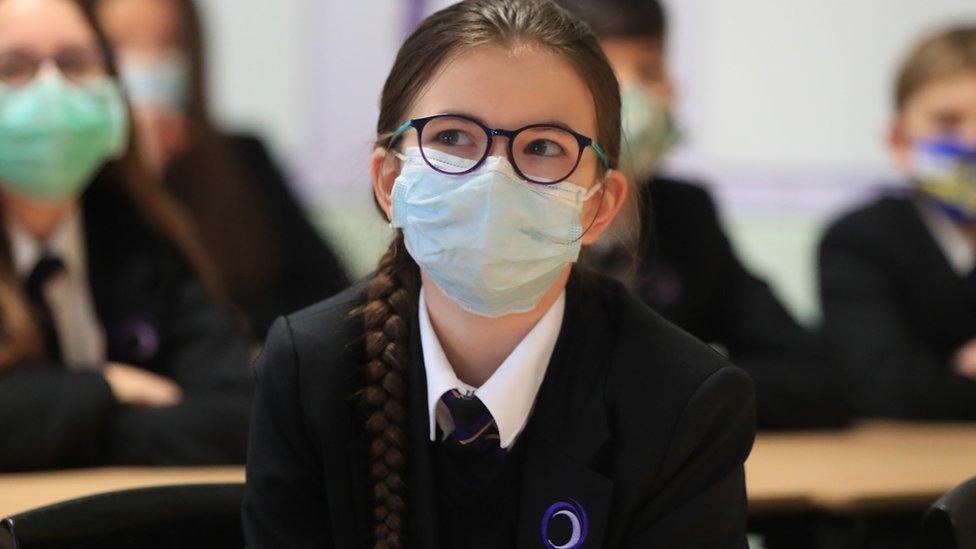Covid: School isolation rules could end in autumn
- Published
- comments
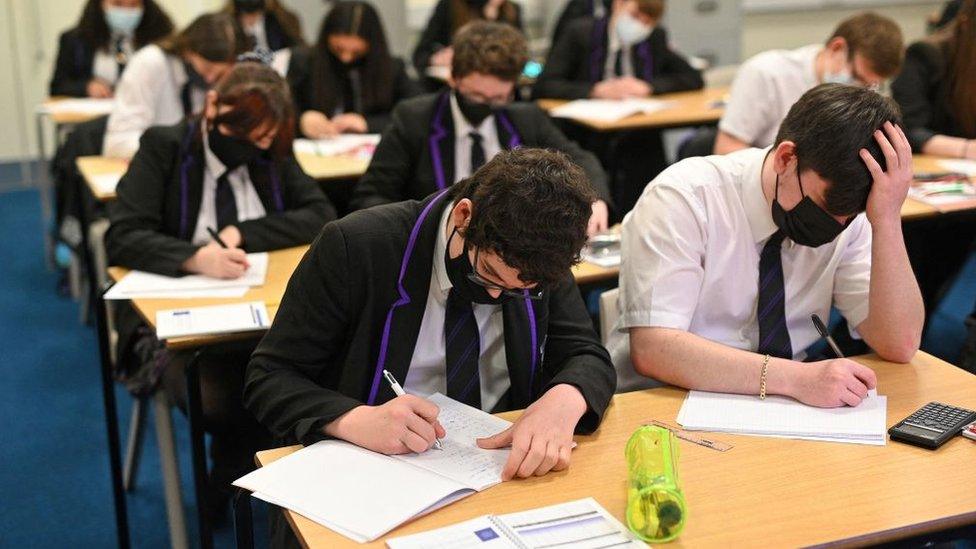
Thousands of schoolchildren are being told to stay at home because they are close contacts of a positive case
The Covid control system in England's schools, where groups of pupils have to self-isolate if one tests positive, could be scrapped in the autumn.
Ministers are looking at asking secondary schools to introduce daily testing instead.
The latest figures show that in England, 279,000 children were self-isolating having potentially been in contact with a positive case in school.
Health Secretary Sajid Javid has pledged to address the issue.
Frustration among parents and teachers is building over the disruption because a rising number of children and their households currently have to quarantine.
The Department for Education said that in order to keep as many children in face-to-face classes as possible, it has written to secondary schools asking them provisionally to prepare for a change after the summer break.
England's Children's Commissioner Dame Rachel de Souza said there was an urgent need for children to get back to normal as lockdown restrictions had been a "real trauma" for many young people.
Grouping pupils into bubbles - often made up of their year group or form which has to quarantine when one child tests positive for Covid - should end as soon as possible, she told the Daily Telegraph, external.
Asked about the self-isolation policy in the Commons on Monday, Mr Javid said it was "having a huge knock-on impact" on children's education.
Steve Chalke, founder of the academies group Oasis Schools, told BBC Radio 4's Today programme that 10% of his pupils - about 3,000 children - were currently off due to Covid, adding it was a "pretty alarming situation and we would say that something needs to be done about this now".
Schools minister Nick Gibb told the BBC the government had brought in "important measures to help us deal with this pandemic".
But he said ministers would be looking at the data from an on-site testing pilot taking place at some secondary schools and colleges before making a decision on whether there is an "effective alternative to self-isolation".
He said the trials involved "daily contact testing, where somebody who has come into contact with somebody with Covid, instead of self-isolating, takes a test every day, and if they are negative they can go into school".
The testing pilot will end on Wednesday.
Official figures for 24 June show that more than 375,000 primary and secondary pupils in England were out of school for Covid-related reasons - an increase of more than 100,000 in a week.
There were also absences because of suspected contacts in the wider community and 24,000 possible infections among students themselves.
Ministers are not expected to make a final decision on self isolation until the results have been examined. But there is a recognition that any change must be announced before the end of term, so it can be implemented after the summer break.
It is unclear whether any future testing would involve primary-age pupils, who to date have not been participating in the government's Covid testing programmes at schools.


Like almost all responses to Covid, automatic self-isolation for pupils who come into close contact with an infected case has both costs and benefits.
When it was established in September it was considered vital to control cases and save lives.
But now vaccines offer the most vulnerable very good protection the benefits of the policy have been reduced.
Meanwhile, the costs have increased because greater numbers are being asked to self-isolate because we are more comfortable about letting Covid spread.
That's why many, from child health experts to teaching unions, are beginning to question the approach. The costs seem disproportionate to the benefits.
But the problem is that it's not clear what it can be replaced with. Rapid testing is being trialled in some secondary schools as an alternative to self-isolation, but we already know these tests have their limitations in terms of being able to spot infection.
Vaccinating children remains an option, but one that government advisers have yet to give the green light to. It is said to be a finely-balanced decision.
It is about finding the least worst option - and that is a very difficult task.
The policy, which sees children sent home for 10 days if they are classed as a close contact of a confirmed case, was established last September - well before the vaccines were rolled out.
Currently, for every one confirmed case there are about 20 pupils isolating at home as a precaution.

Geoff Barton, general secretary of the Association of School and College Leaders, said it was vital the disruption of the past year was brought to an end "as a matter of urgency".
Kevin Courtney, joint general secretary of the National Education Union, said any changes needed "consideration of the logistical challenge facing schools and colleges".
He added: "We should hope for the best - that vaccination of adults solves the problem - but plan for the worst, considering the options around mass testing, vaccination of secondary students, and improvements in ventilation for example."
Chris Dyson, head teacher at Parklands Primary school in Leeds, agreed, saying it was having a damaging effect on the children at his school.
He has recently had to shut one Year 5 class bubble of nine to 10-year-olds because of a positive case.
The children, who will miss extra summer activities like swimming and archery, are "devastated to be at home", he said.
The Scottish government is reviewing its approach to self-isolation for school children, who return to lessons in August.
In Wales, the education minister has said he is looking at best practice to ensure the number of pupils isolating is not disproportionate.
Reporting by Philippa Roxby, Nick Triggle and Alex Kleiderman

COULD COVID HAVE COME FROM A LAB?: Why the controversial theory is now gaining attention
I KNOW WHY THE CAGED BIRD SINGS: Maya Angelou's iconic debut memoir

- Published29 June 2021
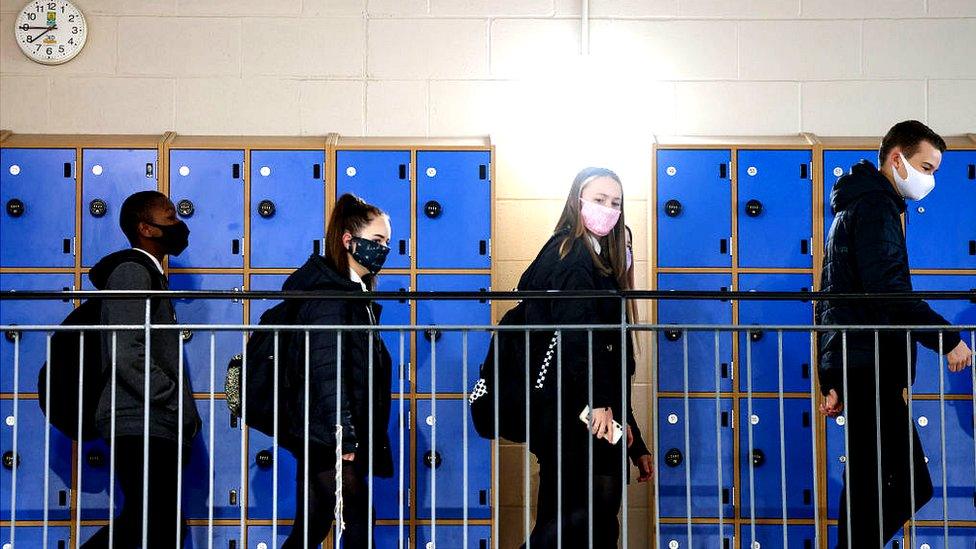
- Published23 June 2021
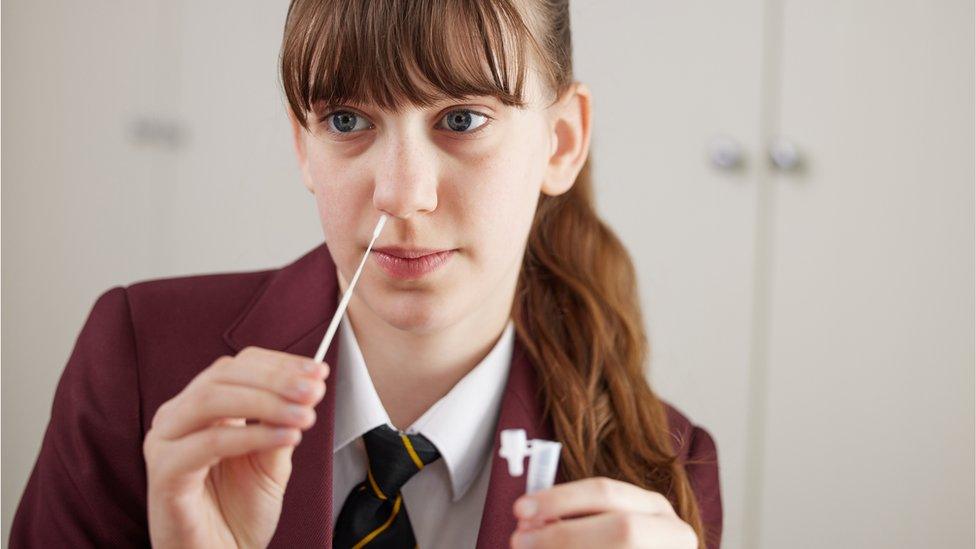
- Published21 June 2021

- Published21 June 2021

- Published17 November 2021
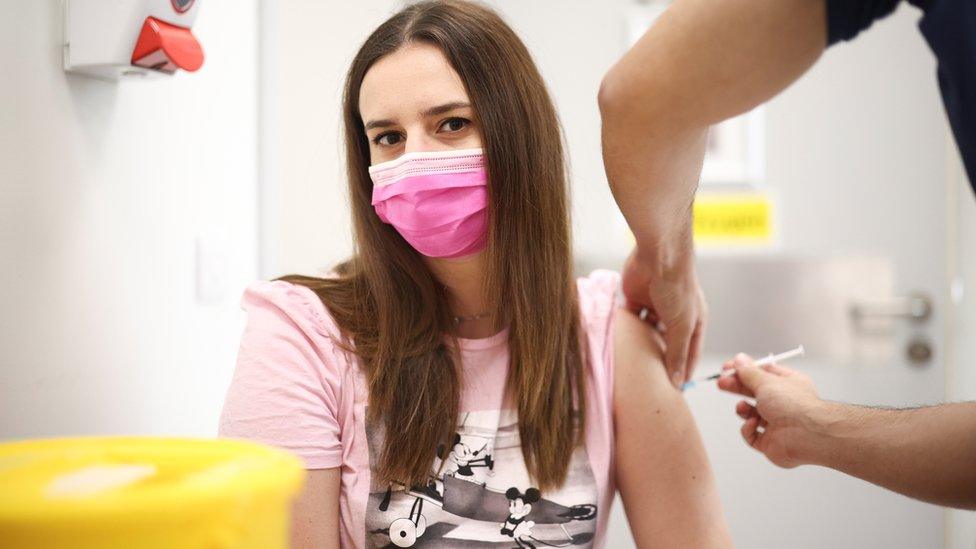
- Published18 June 2021
- Published10 May 2021
